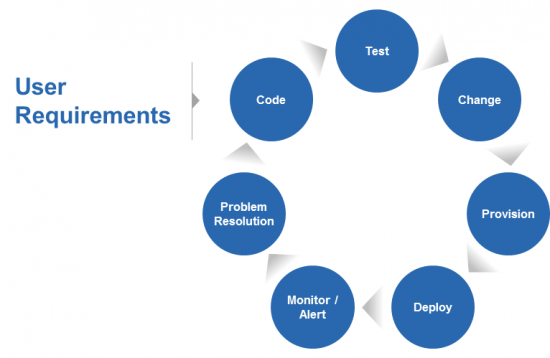































The rate of change is accelerating in IT. The need to provide your enterprise with a competitive advantage and to leverage new technologies is driving the need for rapid change and constant improvement. IT organizations must deliver new business services consisting of new and enhanced applications faster while ensuring SLAs. This environment of frequent and rapid change is what analysts refer to as Mode 2. It requires adopting business practices where development and IT operations work more closely together and more processes are automated. These forces are driving the growing requirement for DevOps and composable infrastructure.
 After watching the videos and reading the press reports from the recent HPE Synergy announcement, you'd think that transitioning to a DevOps and implementing composable infrastructure just requires purchasing the new hardware and launching HPE OneView. Some good marketing, but DevOps is a methodology, not a system. It is an ongoing journey of continuous improvement as well as continuous delivery. Adapting to a faster rate of change requires enhancing processes, better communication and tighter integration of tools as well as some new technology.
After watching the videos and reading the press reports from the recent HPE Synergy announcement, you'd think that transitioning to a DevOps and implementing composable infrastructure just requires purchasing the new hardware and launching HPE OneView. Some good marketing, but DevOps is a methodology, not a system. It is an ongoing journey of continuous improvement as well as continuous delivery. Adapting to a faster rate of change requires enhancing processes, better communication and tighter integration of tools as well as some new technology.
You can embrace the speed of change while minimizing the disruption and risk. We've developed a new brief that explains how you can make the transition to DevOps and composable infrastructure easier using your existing UCS systems, UCS management software and operations management tools.
Download the brief to learn more.
The Journey to DevOps: Infrastructure as Code
DevOps is a growing movement toward processes and methods that facilitate greater communication and collaboration between development, QA, and IT operations. It facilitates continuous delivery by automating the process of software delivery and infrastructure changes by reducing inefficiencies throughout the Software Development Life Cycle (SDLC). Figure 1 below provides an overview of the different phases of the SDLC.
Figure 1: Phases of the Software Development Life Cycle

An important way to speed the rate of change and accelerate the SDLC is to treat the infrastructure as code. By abstracting all configuration and identity of hardware and transforming it into software defined infrastructure (SDI), you're moving down the path to managing the infrastructure as code. Cisco has been executing on our strategy of software defined infrastructure since the introduction of UCS in 2009. UCS management includes four key areas of innovation that treat the infrastructure as code. These four areas provide the foundation for automation of infrastructure management by making the infrastructure programmable. These include:
An essential aspect of implementing DevOps is to increase automated management. You can encapsulate the best practices of your server, storage and network experts in code. These best practices are established as policies and templates, which we call Service Profiles. Service Profiles let you consistently repeat, test, share and promote configurations across your entire environment. Combined with the open API in UCS, they provide a common "language' for provisioning and configuring the infrastructure across the different types of devices. The combination of true SDI and best practices defined in Service Profiles ensures that routine tasks are implemented consistently and correctly to allow you to accelerate the rate of change in the SDLC while reducing the risk.
The Journey to DevOps: Transitioning All of Your Infrastructure
UCS management supports the entire UCS product portfolio. HPE OneView only supports a portion of the HPE server portfolio. The current release HPE OneView provides management for most Gen8 and Gen9 models and some of the G7 BL servers. Most of the G6 BL and DL and G7 DL servers are just monitored, not managed1. OneView doesn't manage or monitor other HPE servers product lines, such as Moonshot, Apollo, Integrity and Cloudline. That means you will probably have to leave many HPE systems behind or use additional management software, if you want to use OneView on your journey to DevOps.
Cisco doesn't have this limitation, because UCS management was baked into the UCS hardware from day 1. The API in UCS management provides a unified control plane. It is a programmatic interface to all of the components in the products and models in the Cisco UCS portfolio. We have used the API to develop plugins and integrations to establish a broad partner ecosystem over the past six years. You can easily extend your existing tools and processes to support any UCS product, including Cisco Composable Infrastructure.
The open API in UCS management accepts XML documents through HTTP or HTTPS. Developers can use any programming language to generate XML documents that contain the API methods. It can present physical and logical resources in the same way virtual and public cloud resources are presented.
Figure 2: The Entire UCS Product Portfolio Is Supported by UCS Management

This approach allows developers to automatically provision and flex their infrastructure for their application requirements. An API call can initiate changes to attributes of one or more objects, including chassis, servers, adapters, drives, policies, and other configurable components. The UCS Manager Developer API toolkit includes PowerTool -PowerShell modules and a Python SDK along with the UCS Platform Emulator. This makes it easier to implement DevOps by integrating existing tools and automating more processes, as it makes sense.
The Journey to DevOps: Composable Infrastructure
Cisco Composable Infrastructure products, including M-Series Modular Servers and C3260 storage server2, are SDI solutions that let you treat infrastructure as code. The architecture of these systems disaggregate the resource components, so they can be programmed and automatically managed more efficiently. The functionality of UCS management has been extended to let you handle your infrastructure resources as fluid pools that can be composed dynamically.
We've been shipping our composable infrastructure products for over a year. They provide significant advantages for many applications and workloads. However, you don't have to purchase these products to continue on your DevOps journey. You can realize the business benefits of DevOps and accelerate the pace of change in your organization today using the UCS B-Series, C-Series and UCS Mini products you already have installed.
Speed the Rate of Change by Making It Easier
You shouldn't have to take on greater risk and disruption to realize the benefits of DevOps. You also shouldn't have to determine whether your older systems can be included in your DevOps journey. Introducing faster rates of change and continuous delivery doesn't have to require significant changes to your existing infrastructure and management software.
As you consider evaluating the HPE Synergy product, remember it is currently in a limited number of beta sites. It will begin shipping later this year, and it requires a brand new, more complex version of HPE OneView to support the completely new functionality in the Synergy hardware.
Cisco UCS makes the transition to DevOps and Mode 2 environments much easier, and it reduces the risk. You can use your existing UCS management software supported by a mature partner ecosystem to implement DevOps efficiently and with less disruption. You can adapt to the requirement for rapid change by going down a path that is smoother and that makes the best sense for your organization.
Download the brief to learn how you can transition to DevOps and composable infrastructure.
Ken
Notes
 Etiquetas calientes:
devops
ucs management
Composable Infrastructure
composable
HPE OneView
HPE Synergy
Etiquetas calientes:
devops
ucs management
Composable Infrastructure
composable
HPE OneView
HPE Synergy